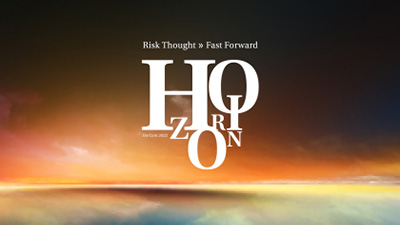The prevention of damage from severe weather events will play an important role in future risk management. To avoid the serious effects of climate change, all stakeholders involved must pull together to reduce greenhouse gas emissions
This summer, Central Europe was hard hit by a severe weather disaster. The low pressure system Bernd caused major flooding and flash flooding in many areas in Belgium, the Netherlands, Austria, Switzerland, Germany and other neighbouring countries. At least 230 people died.
Considering the number of victims, it was the worst natural catastrophe in Germany since the storm surge in 1962. Many houses were damaged or even swept away by the floods. Roads, bridges and other important infrastructure facilities were destroyed. The huge damage required massive aid and rescue measures in some of the affected countries, and the estimated economic loss totalled more than 10 billion EUR. Insurance companies will bear about half of this amount.
These extreme weather events have once again shown the obvious effects of climate change. More and more individuals, companies, and the insurance industry are challenged to change their values as well as their mindset. Measures to slow down or even stop climate change will therefore accompany us more and more often in the future. There will be a shift from traditional to alter- native technologies, especially in production processes. One example is decarbonisation, i.e. phasing out coal as a first measure, followed by abandoning the use of fossil fuels for industrial processes, heating, and as means of operating transport. Most of these steps will impact on the future employment situation in all areas of fossil fuel production. The switch to new technologies and the availability of alternative resources will also give rise to new risks.
Setting of legal framework and voluntary goals
The EU Taxonomy Regulation defines the criteria for sustainable investments. At the same time, it requires financial institutions (including insurance companies) to model and quantify the effects of ESG factors (in particular climate change) in their regular Solvency II stress tests and report on the results. Some insurers have already started to restrict their portfolios to “clean energy” and no longer provide capacities for e.g. coal-fired power plants. The Net-Zero Insurance Alliance, a strategic alliance of several well- known insurance groups, has set itself the goal of converting their underwriting portfolios to net-zero greenhouse gas emissions by 2050.
Insurers can individually decide how to achieve this goal. The list of potential measures includes:
- A definition of underwriting criteria for the most intensive greenhouse gas activities in the underwriting portfolios and the
- Integration of independently de- fined, company-specific net-zero and decarbonisation-related risk criteria into risk management frameworks.
Insurance in a hardening market
The forecast increase in severe weather catastrophes and the resulting damage will lead to higher losses for insurers in the future. It remains to be seen how premiums, specifically for covering natural hazards, will increase and whether there will still be sufficient financial capacities for the insurance of such events.
In the commercial insurance sector, we have been in a hard market phase for the third year in a row.
We have taken note of the fact that the insurers’ risk appetite, especially in sectors with traditionally negative loss records (such as the wood, chemical, and food industries among others) is significantly reduced.
Hence, it is more difficult to provide sufficient insurance cover for such industrial risks if they are increas- ingly exposed to natural hazards. In such cases, the premium level is often no longer decisive. It is, however, far more important to find insurers who are willing to write such risks.
Analysing risks and planning ahead
The prevention of damage from severe weather events will play an important role in future risk management. To avoid the serious effects of climate change, all stakeholders involved must pull together to reduce greenhouse gas emissions. Given the increasing introduction of regulations and measures, companies from CO2-intensive industries will be faced with special challenges.
The analysis of the potential threat from storms and natural hazards will gain in importance in the future. For example, companies looking to invest in a new location are advised to examine the possible exposure
to earthquakes, floods, storms, hail, or other risks as part of their project risk assessment. Similarly, the infra- structure of existing buildings and production plants must be robust and secure to withstand the threat of natural forces. To be better prepared for a possible disaster, appropriate precautions should be taken in the form of emergency plans.
In this context, supply chains also play a key role as disruptions of transport routes due to natural disasters often cause critical bottlenecks in the supply of production-relevant raw materials. Business interruptions are the result. Thinking ahead, setting up alternative routes and supply chains and creating preventive measures can help to avoid major disruptions in production processes in the event of a natural catastrophe.
Alternative insurance solutions take over
Climate change will therefore require higher quality risk management and, at the same time, new, alternative insurance concepts to cover natural perils. Already today there are parametric insurance policies or special “Named Perils” excess layers in addition to conventional insurance coverages available. Parametric solutions trigger a payment from the insurer when predefined parameters (e.g. a defined flood level at the insured’s location) are reached, whereby excess layers provide coverage above a certain deductible, usually following the conventional insurance programme.
Another approach for providing adequate insurance protection for natural disasters are state pool insurance solutions which are already established in some countries. Following the recent severe weather events, insurance associations across Europe are now requesting general compulsory insurance for natural hazards as well as the collaboration with governments to receive their backing in future.
Related articles
Sustainable Construction Articles Series
We invited stakeholders along the value chain to shed light on their strategies, new success models, opportunities and risks in the fight against climate change as part of a mini-series on the topic of “sustainable construction”.
Is Water Scarcity Dangerous for the European Food Industry?
The risk of water scarcity is one of the key considerations in the risk management and ESG policies of food and agriculture companies. But where there’s acute risks, there are huge opportunities for change: Water scarcity concerns are driving innovation in the food industry and with members of the…
What decision-makers need to consider when it comes to ESG
Future-oriented action strengthens strategic resilience.









